- Analytics
- News and Tools
- Quotes
- Chart and quotes for AUDUSD
CFD Trading Rate Australian Dollar vs US Dollar (AUDUSD)
| Date | Rate | Change |
|---|
Related news
-
26.02.2024 11:50AUD/USD finds interim support near 0.6550 as US Dollar comes under pressure
- AUD/USD gauges temporary support near 0.6550 as the US Dollar edges down.
- The US core PCE data will guide forward action in the FX domain.
- Australian monthly CPI is anticipated to accelerate to 3.5% from 3.4% in December.
The AUD/USD discovers support near 0.6550 in the European session on Monday. The sell-off move in the Aussie asset has stalled as the US Dollar drops. The US Dollar Index (DXY) corrects to near 103.76 as hopes of the Federal Reserve (Fed) pivoting to rate cuts are imminent.
S&P500 futures remain muted in the European session, indicating a sideways trend. Investors need fresh insights for rate cuts by the Fed. This week, the United States core Personal Consumption Expenditure (PCE) price index data for January will influence market expectations for rate cuts.
Investors anticipate the monthly core PCE inflation data rose by 0.4% in January from 0.2% growth in December. Annually, the economic data is anticipated to have come out at 2.8% against 2.9% in December.
The consumer price inflation data for January has eased expectations for early rate cuts by the Fed. Last week, Fed Governor Christopher Waller said there is no need to hurry for rate cuts. The risks of reducing interest rates too soon are higher than delaying them.
Meanwhile, the Australian Dollar will be guided by the monthly Consumer Price Index (CPI) data for January, which will be published on Wednesday. Economists have projected that the inflation data rose slightly to 3.5% from the former reading of 3.4%. Sticky inflation data would prompt expectations of one more interest rate hike by the Reserve Bank of Australia (RBA).
-
26.02.2024 10:49AUD/USD languishes near daily low, around mid-0.6500s despite softer USD
- AUD/USD meets with some supply on Monday, though the downside remains cushioned.
- Retreating US Treasury bond yields undermines the USD and lends support to the major.
- Traders also seem reluctant to place directional bets ahead of this week’s key macro data.
The AUD/USD pair attracts some sellers on Monday following the recent repeated failures to find acceptance above the 100-day Simple Moving Average (SMA) and remains depressed through the first half of the European session. Spot prices currently trade around the mid-0.6500s, though lack follow-through amid a modest US Dollar (USD) downtick.
The USD Index (DXY), which tracks the Greenback against a basket of currencies, struggles to capitalize on last week's goodish rebound from its lowest level since February 2 amid retreating US Treasury bond yields. Apart from this, the Reserve Bank of Australia's (RBA) hawkish stance, signalling that policymakers are unwilling to rule out another cash rate increase in the wake of sticky inflation, is seen lending some support to the AUDUSD pair.
Any meaningful USD downfall, however, seems elusive in the wake of firming expectations that the Federal Reserve (Fed) will wait until the June FOMC policy meeting before cutting interest rates. Furthermore, the risk of a further escalation of tensions between China and Taiwan, along with persistent geopolitical tensions stemming from the Middle East, could undermine the risk-sensitive Australian Dollar (AUD) and cap the AUD/USD pair.
The aforementioned mixed fundamental backdrop warrants some caution before placing aggressive directional bets ahead of this week's important macro releases, including the latest Australian consumer inflation figures on Wednesday. The market focus will then shift to Thursday's release of the US Core PCE Price Index – the Fed's preferred inflation gauge – and the official PMI prints from China, scheduled for release on the last day of the week.
-
25.02.2024 23:03AUD/USD gains ground above the mid-0.6500s, investors await Australian CPI data
- AUD/USD holds positive momentum around 0.6565 in Monday’s early Asian session.
- Several Fed officials stated that they are worried about the risk of cutting rates too soon rather than keeping them high for too long.
- The Reserve Bank of Australia (RBA) said in its meeting minutes that another rate hike cannot be ruled out.
- The Australian monthly Consumer Price Index (CPI) and US Gross Domestic Product Annualized (Q4) will be closely watched events.
The AUD/USD pair holds above the mid-0.6500s during the early Asian session on Monday. The pair maintain the upward momentum, with the US Dollar Index (DXY) hovering around the 104.00 mark. The market is likely to be quiet on Monday, and investors await the Australian monthly CPI on Wednesday for fresh impetus. AUD/USD currently trades near 0.6565, gaining 0.04% on the day.
Several Federal Reserve (Fed) officials emphasized last week that they are worried about the risk of cutting interest rates too soon or too much rather than keeping them high for too long and damaging the economy. The US central bank wants to see further evidence that inflation is on a path to its 2% target before lowering interest rates. That being said, the higher-for-longer rate narrative in the US might cap the downside of the US Dollar (USD) and act as a headwind for the AUD/USD pair.
The markets anticipated the Fed to cut its rate in May or June meeting, while the Fed’s Christopher Waller hinted that the first rate cuts could come later this year. Investors will take more cues from the Core Personal Consumption Expenditures Price Index (Core PCE), the Fed's preferred inflation measure, which is estimated to show an increase of 0.4% MoM and 2.8% YoY in January.
On the Aussie front, the Reserve Bank of Australia (RBA) kept its cash rate steady at 4.35% earlier this month. The Australian central bank indicated in its meeting Minutes that inflation would return to target within a reasonable timeframe, even though this process would take some time. However, other rate hikes cannot be ruled out.
The Australian monthly Consumer Price Index (CPI) for January will be due on Wednesday, and the Retail Sales will be released on Thursday. On the US docket, the Gross Domestic Product Annualized (Q4) and Core CPE will be in the spotlight this week, due on Wednesday and Thursday, respectively, -
23.02.2024 14:25AUD/USD to end 2024 around 0.7200, further appreciation through 2025 – NAB
Economists at the National Australia Bank still expect AU/USD to trend higher. However, they have pushed out their forecasts for the Aussie by a quarter.
AUD/USD still expected to appreciate
We have pushed out our forecasts for AUD/USD by a quarter, now expecting the Aussie to end 2024 around 0.7200.
We continue to see a further appreciation through 2025 with the AUD/USD pair reaching 0.7800 by Q4.
See:
- AUD/USD could struggle to trade consistently above 0.7000 – ING
- AUD/USD to maintain positive momentum – Commerzbank
-
23.02.2024 10:04AUD/USD drops to fresh daily low, around mid-0.6500s amid modest USD uptick
- AUD/USD fails to preserve its modest intraday gains amid the emergence of some USD buying.
- The Fed’s hawkish outlook supports elevated US bond yields and is seen underpinning the buck.
- A minor pullback in the equity markets further drives flows away from the risk-sensitive Aussie.
The AUD/USD pair continues with its struggle to find acceptance or build on its strength beyond the 100-day Simple Moving Average (SMA) and attracts some intraday sellers near the 0.6580 region on Friday. The downfall picks up pace during the first half of the European session and drags spot prices to a fresh daily low, around mid-0.6500s amid a modest US Dollar (USD) uptick.
Against the backdrop of persistent geopolitical tensions stemming from conflicts in the Middle East, fading hopes for early rate cuts by global central banks keep a lid on the recent optimism. This is evident from a minor pullback in the equity markets, which assists the safe-haven USD to gain some positive traction and undermines the risk-sensitive Aussie. The Greenback is further supported by the Federal Reserve's (Fed) hawkish outlook, which, in turn, exerts some downward pressure on the AUD/USD pair.
The minutes of the late January FOMC meeting released on Wednesday showed a broad uncertainty about how long borrowing costs should remain at their current level to bring down inflation back to the central bank's 2% target. Adding to this, comments by a slew of influential Fed policymakers suggested that the US central bank is in no hurry to cut interest rates. This remains supportive of elevated US Treasury bond yields and allows the USD to recover further from a nearly three-week trough touched on Thursday.
Moving ahead, there isn't any relevant market-moving economic data due for release from the US on Friday, leaving the USD at the mercy of the US bond yields. Apart from this, the broader risk sentiment might drive demand for the safe-haven buck and provide some impetus to the AUD/USD pair. Nevertheless, spot prices remain on track to register modest gains for the third straight week, though the lack of follow-through buying warrants some caution for bullish traders and before positioning for any further gains.
-
22.02.2024 23:19AUD/USD aims higher amid upbeat mood, mixed US data
- AUD/USD modestly up at 0.6559, after peaking at 0.6595, with technical levels influencing movement.
- Solid US job data and economic expansion hints keep Fed rate hike expectations alive, impacting the Aussie.
- Fed officials' comments reflect cautious optimism on inflation, hinting at a data-driven approach to future rate cuts.
The Aussie Dollar registers minuscule gains against the US Dollar as Friday’s Asia session begins. The pair remains capped on the upside despite hitting a new month high at 0.6595, as a key technical resistance level that acted like a magnet drove the exchange rate toward the 0.6550s area. At the time of writing, the AUD/USD trades at 0.6559, up 0.06%.
Aussie touches monthly high but faces key resistance at 200-DMA
Wall Street ended Thursday’s session at all-time highs, portraying an upbeat market mood. US employment data was solid as the US Bureau of Labor Statistics (BLS) revealed that unemployment claims for the week ending on February 17, dropped to 201K from 213K, and below the consensus. At the same time, S&P Global's mixed February Flash PMI data, indicating economic expansion, supports the case for the US Federal Reserve to maintain elevated interest rates for a longer duration to address inflationary pressures.
The data sponsored a jump in the short end of the US Treasury bond yield curve, and capped the US Dollar’s (USD) losses, according to the US Dollar Index (DXY) at 103.94, down 0.05%. In the meantime, Federal Reserve officials crossed the wires, led by Vice-Chair Philip Jefferson, Philadelphia Fed President Patrick Harker, and Governor Lisa Cook.
Fed Jefferson said he’s optimistic about the progress on inflation, and despite adding that rate cuts could happen later, he remains data-dependent. Meanwhile, Philadelphia Fed Patrich Harket said the central bank is on track for a rate cut this year, and despite putting a May rate cut on the table, it’s not his base case scenario. Last but not least, Lisa Cook said she needs more confidence in inflation before cutting rates.
AUD/USD Price Analysis: Technical outlook
The AUD/USD daily chart is neutral to downward biased, with the exchange rate bracing at around the 200-day moving average (DMA) at 0.6561. A decisive break to the upside would pave the way to challenge Thursday’s high at 0.6595 ahead of 0.6600. On the other hand, a drop below the 0.6500 mark would sponsor a leg-down toward the current year-to-date (YTD) low of 0.6442.

-
22.02.2024 13:41AUD/USD Price Analysis: Corrects from 0.6600 as US Dollar finds temporary support
- AUD/USD falls vertically from 0.6600 as the US Dollar gets a firm footing.
- Deepening geopolitical tensions have improved safe-haven appeal.
- Fed policymakers are less likely to cut interest rates soon.
The AUD/USD pair falls sharply after a steep rally to the round-level resistance of 0.6600 in the early New York session on Thursday. The Aussie asset faces a sell-off as the US Dollar has rebounded amid deepening Middle East tensions.
The Israeli army has intensified bombarding on Rafah, the southern region of Gaza in Palestine, as the former hopes that over 1.4 million refugees have been sheltered there. Escalating Middle East tensions have improved the appeal for safe-haven assets.
Meanwhile, the Federal Open Market Committee (FOMC) minutes for January’s policy meeting indicated that policymakers don’t want to cut interest rates early amid lack of conviction on the progress in inflation declining to the 2% target.
The Australian Dollar remains bullish lately as the Reserve Bank of Australia (RBA) minutes for February policy meeting indicated that policymakers were interested in raising the Official Cash Rate (OCR) further. It indicates that the current monetary policy of the RBA is not sufficiently restrictive to tame sticky price pressures.
Going forward, investors will focus on the United States preliminary S&P Global PMI data for February, which will be published at 14:45 GMT.
AUD/USD strengthens after a breakout of the Falling Pennant chart pattern formed on a four-hour scale. A breakout of the aforementioned pattern indicates a bullish reversal. The breakout of a Falling Pennant happens when selling pressure dries, and investors consider it a value-buy.
The 20-period Exponential Moving Average (EMA) near 0.6550 continues to provide support to the Australian Dollar bulls.
The 14-period Relative Strength Index (RSI) struggles to sustain in the 60.00-80.00 region. A bullish momentum would trigger if the RSI (14) manages to do so.
Fresh upside would appear if the asset breaks above the round-level resistance of 0.6600, which will drive the asset towards January 30 high at 0.6625, followed by December 4 high at 0.6688.
In an alternate scenario, a downside move below February 15 low at 0.6477 would activate sellers and will expose the asset to February 13 low at 0.6443 and the round-level support of 0.6400.
AUD/USD four-hour chart
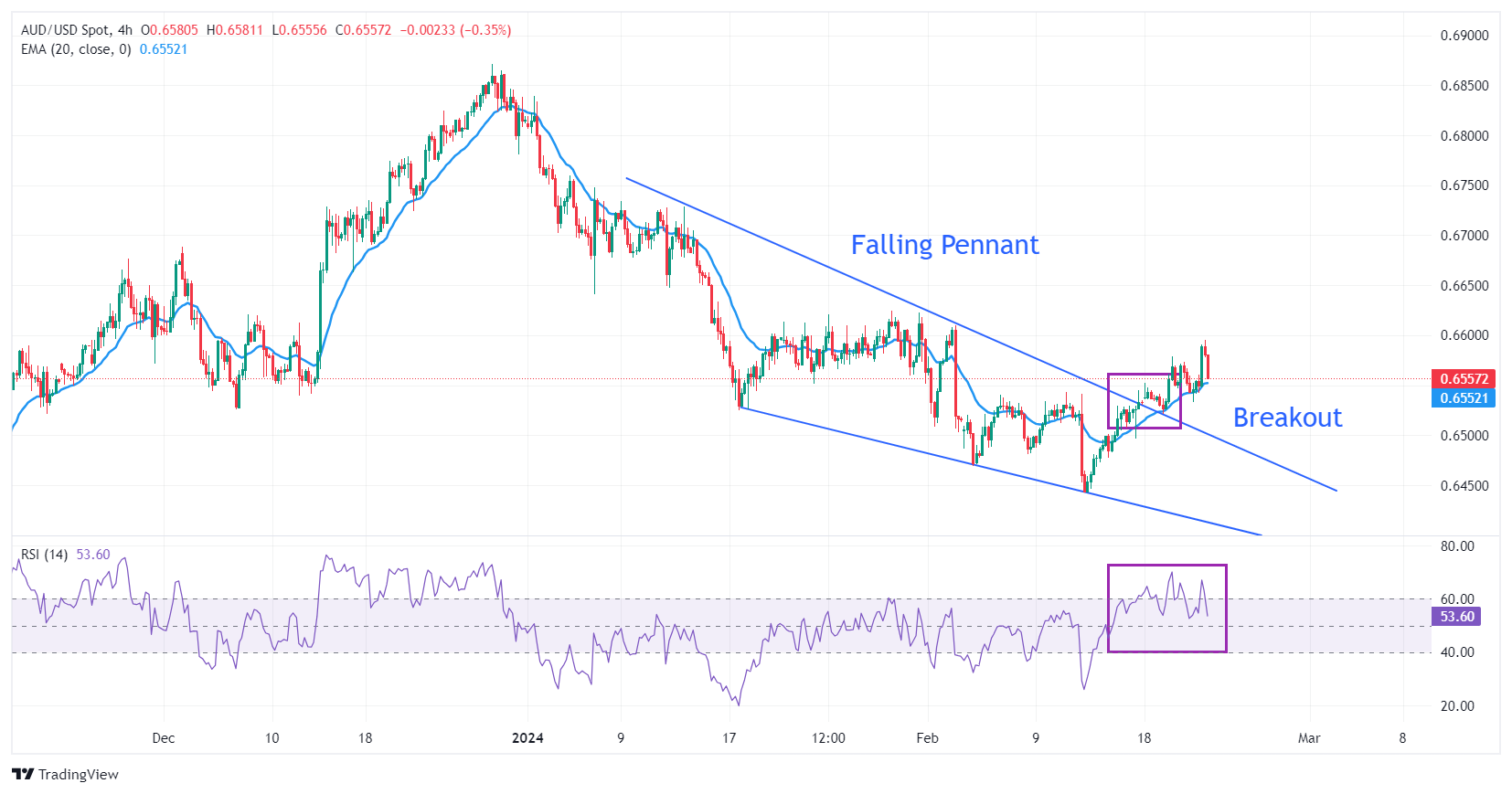
-
21.02.2024 22:46AUD/USD prints slight gains post-FOMC minutes, mixed Aussie PMIs
- AUD/USD marginally down at 0.6550 after Fed reiterates hesitancy on rate cuts amid inflation concerns.
- US 10-year Treasury yields rise, while the DXY dips slightly, reflecting the Fed's cautious outlook.
- Mixed Australian PMI data shows services growth but manufacturing contraction, complicating RBA's policy path.
The Australian Dollar posted minuscule gains on Wednesday against the US Dollar, after the release of the Federal Reserve’s January meeting minutes emphasized policymakers remain hesitant to begin to ease policy. Therefore, the AUD/USD exchanges hands at 0.6550, down by 0.02% as the Asian session begins.
FOMC’s minutes failed to underpin the Greenback
The AUD/USD was subdued throughout most of the session until the minutes were released. The minutes showed that Fed officials are cautious about reducing interest rates prematurely. They stated that they would not consider it suitable to lower interest rates until there is "greater confidence" that inflation is on a sustainable path toward the 2% target. Despite recognizing that the risks associated with fulfilling both Fed’s mandates—price stability and maximum employment—are becoming more balanced, officials emphasized their continued focus on inflationary risks. They also noted that although the economic risks are tilted towards the downside, vigilance towards inflation remains a priority.
After the data, the US 10-year Treasury note yield resumed to the upside, ending the session three and a half basis points up at 4.319%, while the US Dollar fell. The US Dollar Index (DXY) an index that measures the currency’s performance against other six, dropped 0.05%, at 103.99.
Fed speakers remain hawkish, Aussie’s Manufacturing PMI contracts
The Richmond’s Fed President Thomas Barkin crossed the newswires, saying the latest inflation data is “less good,” expressing worries about services inflation.
In the meantime, the Judo Bank Flash PMIs for February were released, with the Composite and Services exceeding January’s readings and exiting from recessionary territory. The Services PMI came at 52.8, up from 491, and the Composite PMI was 51.8, up from 49. The outlier was Manufacturing, which came at 47.7, missing December’s 50.1, suggesting that manufacturing activity is contracting.
Warren Hogan, Chief Economist Advisor at Judo Bank said: “The February Flash PMI results weaken the case for monetary policy easing any time soon. If anything, the improvement in activity indicators in 2024 and a slight uptick in the price indexes suggest that the risks to monetary policy remain even balanced.”
AUD/USD Price Analysis: Technical outlook
the AUD/USD continued to trade sideways after the release of the Fed’s minutes, though sellers stepped in around the 200-day moving average (DMA) at 0.6561, dragging prices below the 0.6550 area. If they would like to remain in charge, the pair must drop below the 100-DMA at 0.6547 and extend below the 0.6500 figure. Once that area is cleared, the next support emerges at the current year-to-date (YTD) low of 0.6442. On the upside, if buyers reclaim the 200-DMA, look for a challenge at the 0.6600 threshold.
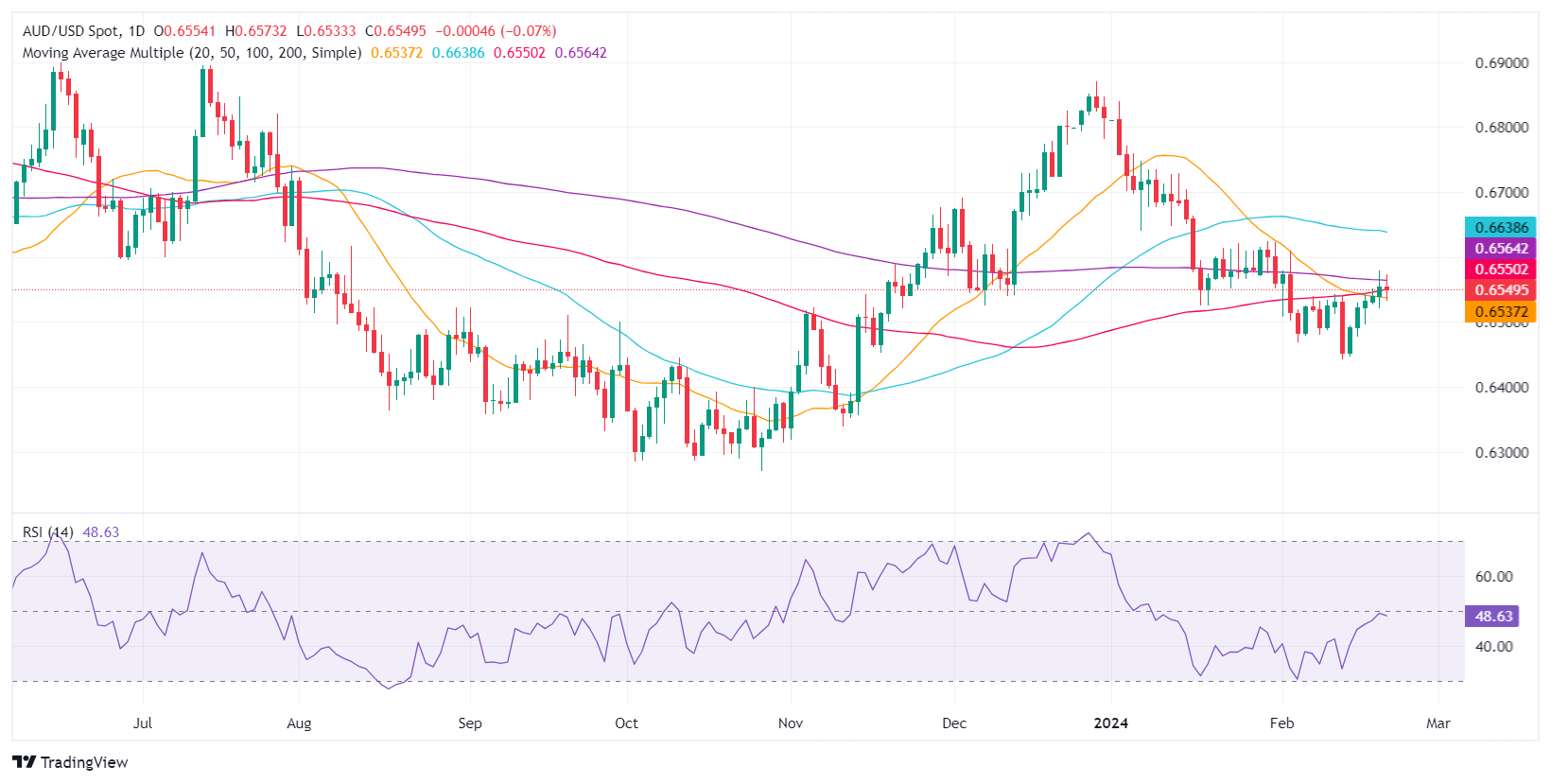
-
21.02.2024 15:27AUD/USD could struggle to trade consistently above 0.7000 – ING
Disappointment summarises the start of 2024 for the Australian Dollar (AUD). Economists at ING analyze Aussie’s outlook.
Softer data does not mean big RBA cuts
Australian inflation declined more than expected in the fourth quarter, and the RBA’s pushback against rate cut bets was also challenged by soft employment figures for January. That said, we do not doubt the determination of the RBA to keep rates higher for some time. Our expectations remain that monetary easing in Australia will only be a story for the second half of the year and be worth a total of 50 bps – significantly less than the Fed and RBNZ.
AUD is in a good position to rally once US data allows rate cut bets to rebound in the US, even though potential defensive positioning ahead of US elections in the third quarter (a Trump re-election would hit China-related sentiment) means AUD/USD could struggle to trade consistently above 0.7000.
-
21.02.2024 09:16AUD/USD to maintain positive momentum – Commerzbank
AUD/USD has made some gains recently to come close to the 0.6600 level. Economists at Commerzbank analyze the pair’s outlook.
The RBA will probably stick to its restrictive stance
Unless there are surprises in terms of inflation and growth, the RBA will probably stick to its restrictive stance for the time being.
Unlike other major central banks, interest rate cuts are unlikely to be an issue for the time being. This should support the AUD. However, developments in China remain a risk factor that should be kept in mind.
-
20.02.2024 17:45AUD/USD pulls back from 0.6580 after RBA-fueled rally
- AUD/USD climbed after the RBA pondered rate cuts.
- The Aussie’s extended recovery got hampered after falling just short of 0.6580.
- Fed watchers will be pivoting to Wednesday’s FOMC Meeting Minutes.
The AUD/USD climbed on Tuesday, rebounding from the day’s low near 0.6520 to fall just shy of 0.6580 before pulling back into the day’s range. The Reserve Bank of Australia (RBA) held rates steady early Tuesday as markets broadly expected, but another rate hike is still in the ether and investors will be looking to suss out how close the Federal Reserve (Fed) is to cuttign interest rates when the Federal Open Market Committee’s latest Meeting Minutes drop on Wednesday.
The RBA held rates for the time being, but the Australian central bank’s internal dialogue appears to be leaning towards further rate cuts if faster progress isn’t made on inflation soon. With Australia’s lop-sided economy grappling with a tight labor market and still-high services inflation, the RBA expects it could take until well into 2025 before inflation reaches target levels.
RBA Minutes: Board considered a hike of 25bp or an on hold decision
With the potential for another rate hike on the table, the Aussie (AUD) climbed through Tuesday’s early trading session, before getting pared back during the US market window.
The mid-week trading session will see eyes on the Fed and its FOMC’s latest Meeting Minutes, slated to release at 19:00 GMT on Wednesday. Investors will be looking to see how close the Fed is to delivering interest rate cuts, with the market broadly expecting a first rate trim in June or July, according to the CME’s FedWatch Tool.
AUD/USD technical outlook
The AUD/USD found its highest bids in nearly three weeks on Tuesday, climbing towards 0.6580 but falling just short of the interim level before getting pulled back into 0.6550 on stiffer US Dollar (USD) flows. The pair is grappling with a low-conviction recovery from the last swing low into 0.6450, and bullish momentum is running into a technical ceiling at the 200-day Simple Moving Average near 0.6565.
Beyond near-term price action, a heavy resistance zone from 0.6620 to 0.6600 weighs on bullish momentum into the medium-term.
AUD/USD hourly chart

AUD/USD daily chart
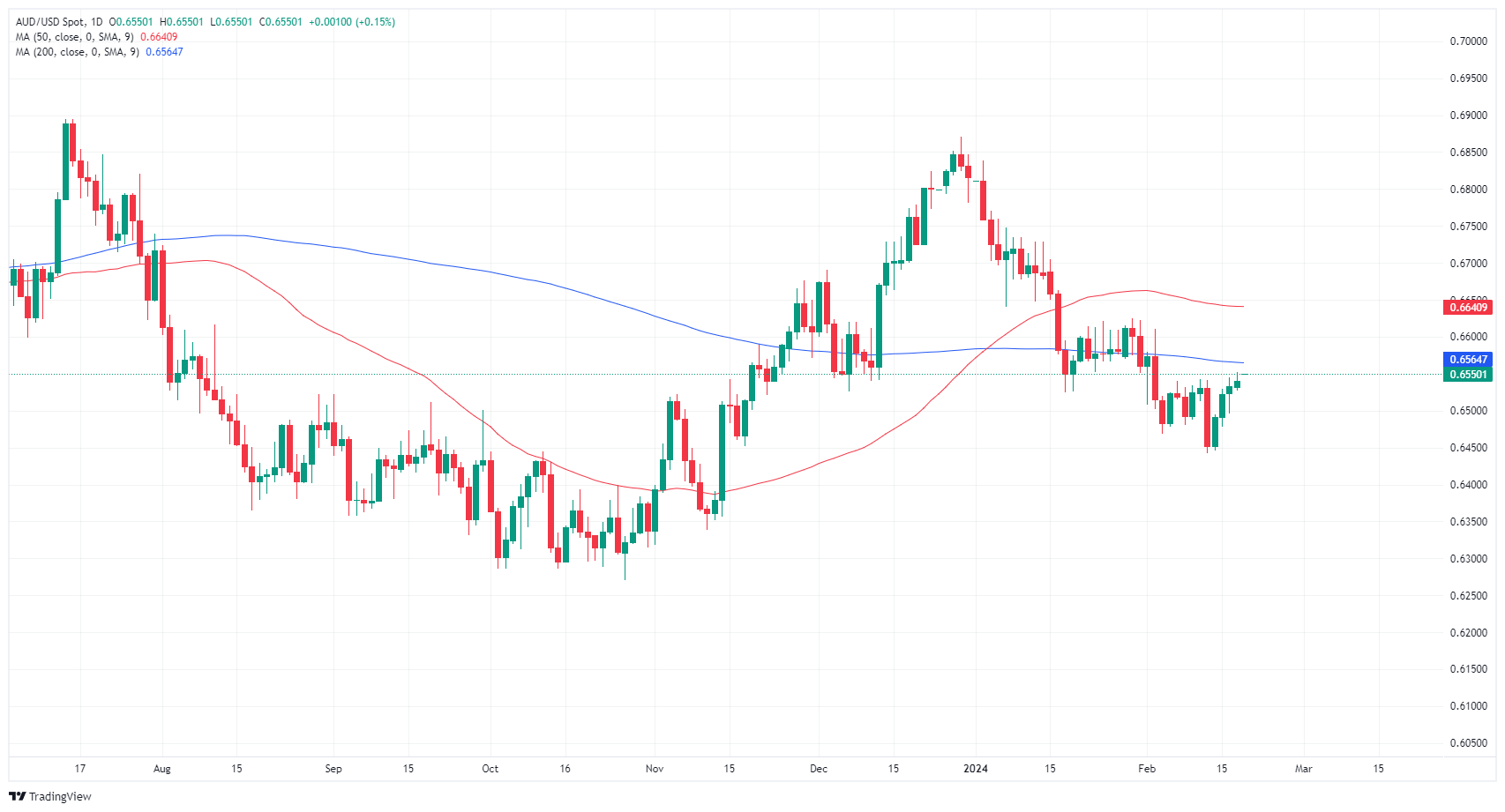
-
19.02.2024 23:40AUD/USD loses ground below the mid-0.6500s, eyes on RBA Meeting Minutes, PBoC rate decision
- AUD/USD trades on a softer note near 0.6532 amid the modest rebound of the USD.
- RBA’s Bullock said last week that all options are still on the table in terms of monetary policy decisions.
- The RBA Meeting Minutes and the People’s Bank of China's (PBoC) interest rate decision will be closely watched events.
The AUD/USD pair loses traction below the mid-0.6500s during the early Asian trading hours on Tuesday. The Reserve Bank of Australia (RBA) will publish the minutes of its February monetary policy meeting later in the day. The pair currently trades around 0.6532, down 0.12% on the day.
The RBA governor Michele Bullock said all options are still on the table in terms of monetary policy decisions. However, the central bank needs to make sure that it doesn’t have to backtrack on inflation, and that inflation doesn't get away. Deutsche Bank analysts showed earlier this month that they expected the RBA to cut interest rates as early as May. Still, most analysts anticipate the Reserve Bank to ease policy between June and December.
On the USD’s front, the Federal Reserve (Fed) shifted to a more dovish stance in December, with markets now pricing in rate cuts by summer. Investors will take more cues from the FOMC minutes for the January meeting, with the focus on any discussion around the timing of rate cuts. The markets anticipate the first 25 basis points (bps) rate cut in 2024 as early as June, according to the CME FedWatch Tools.
Market players will keep an eye on the RBA Meeting Minutes, followed by the People’s Bank of China (PBoC) interest rate decision on Tuesday. A poll of 27 market watchers conducted this week showed that 92.6% of respondents anticipated the five-year LPR to be cut on Tuesday. They expected a reduction of five to 15 basis points.
-
19.02.2024 19:30AUD/USD buckles down ahead of RBA, testing 0.6550
- AUD/USD holding steady near 0.6550 with RBA due early Tuesday.
- Wednesday brings the latest FOMC Meeting Minutes from the Fed.
- Australian Judo Bank PMIs slated for early Thursday.
AUD/USD is paddling in circles just below 0.6550 as the pair pulls into the center ahead of Tuesday’s showing from the Reserve Bank of Australia (RBA). Wednesday sees the Federal Reserve’s (Fed) latest Meeting Minutes from the Federal Open Market Committee (FOMC), and early Thursday sees Australia’s latest Purchasing Manager’s Index (PMI) figures for February.
The RBA is expected to hold steady on Tuesday and keep rates pinned where they are. Aussie labor figures disappointed markets recently, but it will likely take several months of soft employment numbers before the RBA gets pushed into a rate cut cycle.
The FOMC’s latest Meeting Minutes, due Wednesday, are going to draw plenty of investor attention as markets try to suss out when the US central bank will begin trimming interest rates. US inflation and a still-tight US labor market continue to flummox rate cut hopes from broader markets. Money markets are currently pricing in a first rate cut from the Fed in June, with the CME’s FedWatch Tool forecasting a 75% chance of at least 25 basis points in rate cuts in June, with at least a further 25 basis points expected in July.
The back half of the trading sees Australian Judo Bank PMI numbers for February, and the Composite Aussie PMI has only printed above 50.0 for four of the last twelve successive prints. Australia’s Judo Bank Services PMI last came in at 49.1, while the Manufacturing component last printed at 50.1.
AUD/USD technical outlook
AUD/USD bounced off the 200-hour Simple Moving Average (SMA) near 0.6510 late last week, leaving the pair positioned in the high end near-term, and the pair is poised for a fresh bullish run at the 0.6600 handle with the Aussie extending a recent bullish reversal. The pair is finding some technical resistance at recent swing highs into 0.6540.
The AUD/USD is looking for a foothold from a recent bottom near 0.6450 after the pair declined from December’s peak near 0.6870, and the pair is still down nearly 5% as January market flows struggle to stem the bearish tide.
AUD/USD hourly chart
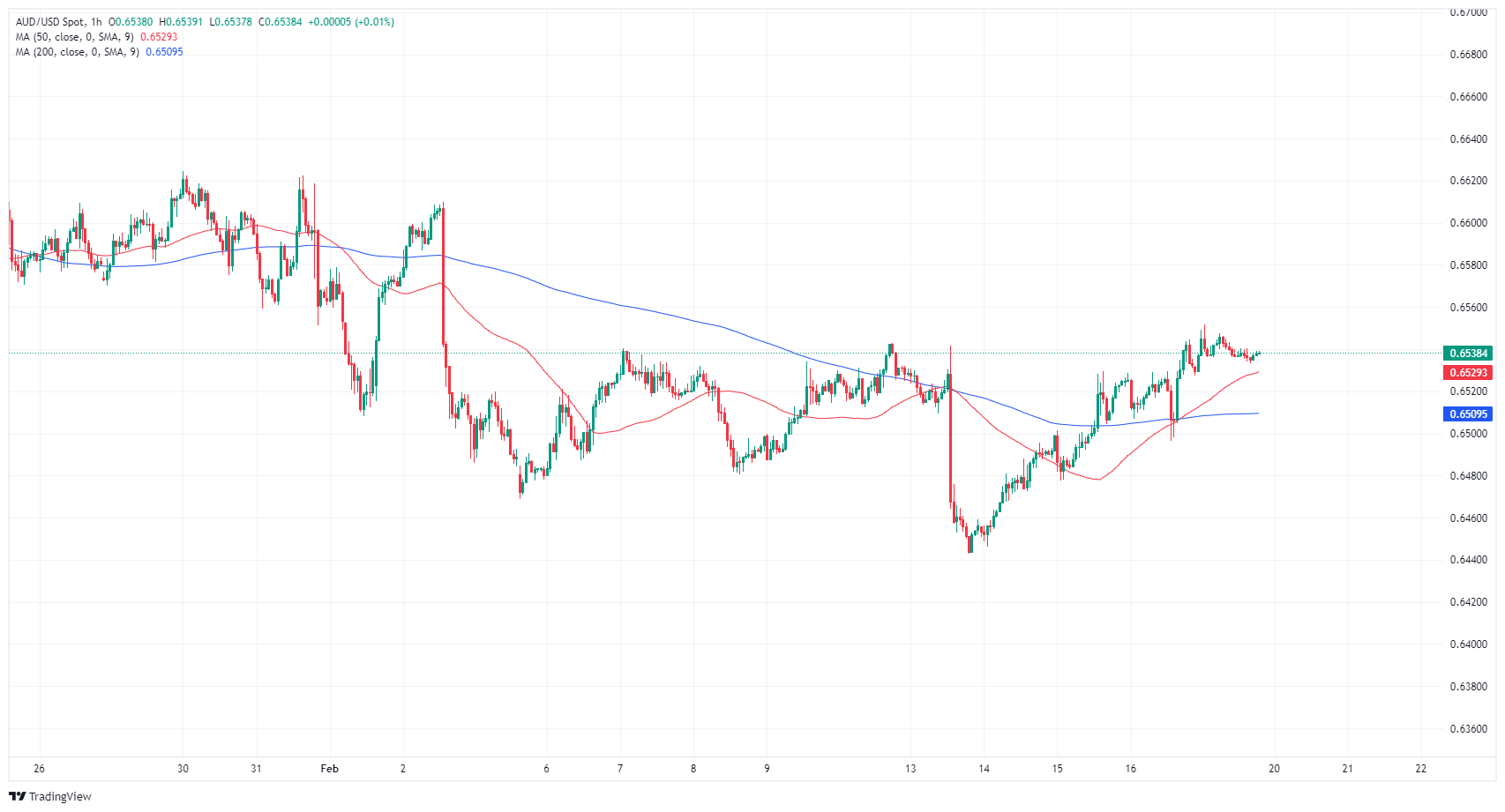
AUD/USD daily chart
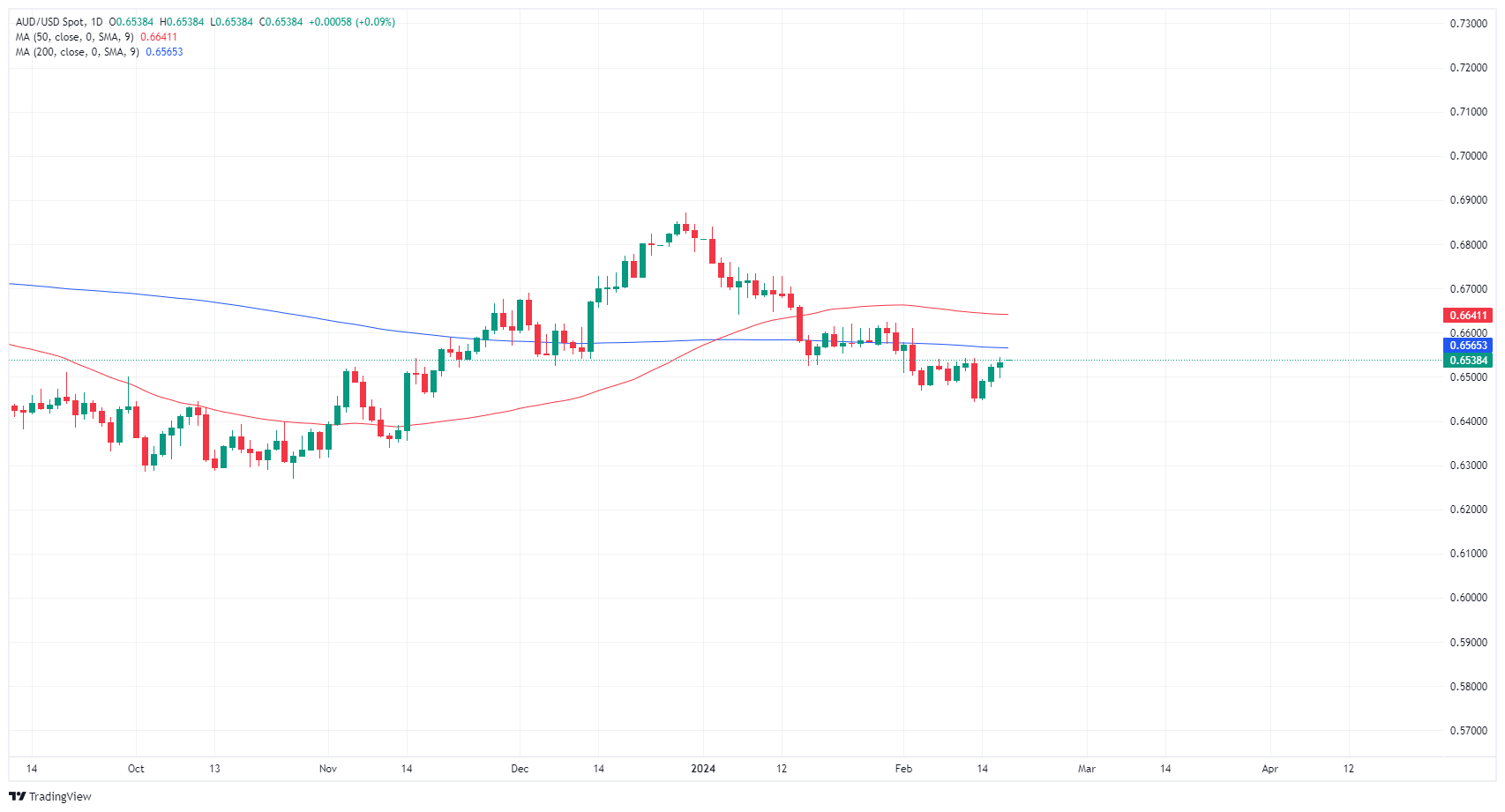
-
19.02.2024 13:48AUD/USD Price Analysis: Turns sideways near fresh two-week high around 0.6550
- AUD/USD trades back and forth near weekly high ahead of the Fed and the RBA minutes.
- The reopening of Chinese markets has provided some strength to the Australian Dollar.
- Stubborn US price pressures fail to provide support to the US Dollar.
The AUD/USD pair consolidates in a narrow range after a sharp rally to near 0.6550 in Monday’s late European session. The Aussie asset is expected to remain on edge ahead of the release of the Reserve Bank of Australia (RBA) and the Federal Reserve (Fed) minutes on Tuesday and Wednesday, respectively.
The reopening of Chinese markets after the Lunar New Year celebrations has improved the appeal of the Australian Dollar. Investors will focus on the interest rate decision by the People’s Bank of China (PBoC), which will be announced on Tuesday. The PBoC is expected to maintain a dovish stance as the Chinese economy faces deflation amid weak household spending and lower employment opportunities.
Being a proxy to the Chinese economy, the Australian Dollar strengthens on stimulus support from the PBoC.
Meanwhile, the US Dollar Index (DXY) remains under pressure despite robust United States consumer price inflation and Producer Price Index (PPI) data for January have dampened hopes of rate cuts by the Federal Reserve (Fed).
AUD/USD delivers a solid rally to near weekly high around 0.6540 on an hourly scale. The near-term outlook of the Aussie asset has turned bullish as it has stabilized above the 200-period Exponential Moving Average (EMA), which trades around 0.6517.
The 14-period Relative Strength Index (RSI) trades in the bullish range of 40.00-80.00, indicating more upside ahead.
More upside will appear if the asset breaks above the intraday high of 0.6552, driving the asset towards the round-level resistance of 0.6600, followed by the January 30 high at 0.6625.
In an alternate scenario, a downside move below February 15 low at 0.6477 would activate sellers and expose the asset to February 13 low at 0.6443 and the round-level support of 0.6400.
AUD/USD hourly chart
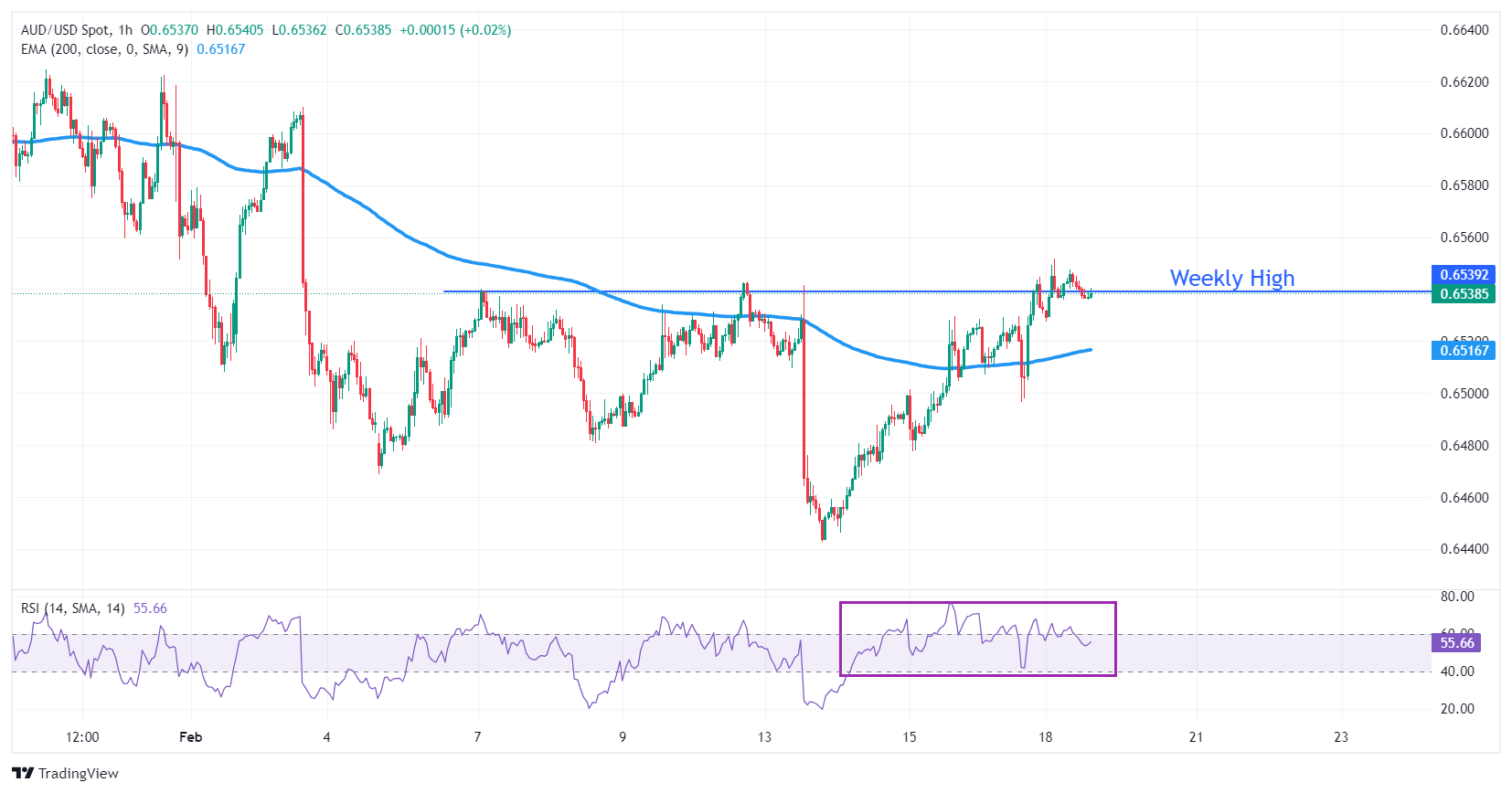
-
19.02.2024 08:51AUD/USD to push higher later in the year – Rabobank
Having reached a late December high around 0.6871, AUD/USD dipped to 0.6500 this month. Economists at Rabobank analyze Aussie’s outlook.
EUR/AUD to trend lower to 1.5600 on a 12-month view
At first sight, the Australian January Labour data encouraged the view that the economy is cooling, this sparked speculation that the RBA may bring forward the first rate cut of the cycle. That said, it is very likely that policymakers will need a lot more economic data before making a policy decision.
To date, the RBA has remained one of the more hawkish G10 central banks and Rabobank expects that rates are likely to remain on hold until Q4.
Assuming the Fed cuts rates first, this should allow AUD/USD to push higher later in the year.
Reflecting the relative resilience of the Australian economy compared to Germany, we also expect EUR/AUD to trend lower to 1.5600 on a 12-month view.
-
18.02.2024 23:05AUD/USD gains ground below the mid-0.6500s, eyes on RBA minutes
- AUD/USD trades in positive territory for four consecutive days near 0.6530.
- The US January PPI came in stronger than expected, rising 0.3% MoM and 0.9% YoY.
- Financial markets are betting that the RBA will cut rates in the middle of the year.
The AUD/USD pair kicks off the new week on a positive note during the early Asian session on Monday. The uptick of the pair is supported by the decline of the US Dollar (USD). AUD/USD currently trades around 0.6530, losing 0.03% on the day.
Data released by the US Labor Department on Friday showed that the Producer Price Index (PPI) in January increased by 0.3% MoM from a 0.1% decline in December. The gauge rose 0.9% in a year, also exceeding forecasts. The stronger data represent a rise in inflation pressure at the start of 2024. However, the Federal Reserve (Fed) needs more data to consider before starting to cut the interest rate.
Meanwhile, the upside of the pair might be capped by the rising tensions in the Middle East. The leader of Hezbollah, the Iran-backed militant group said it will broaden its war against Israel in the wake of recent strikes between the two sides. This, in turn, could boost a safe-haven currency like the US Dollar (USD) and act as a headwind for the AUD/USD pair.
The Reserve Bank of Australia (RBA) hasn't been expected to cut rates until after the Fed. Investors are pricing in August as the likely start for RBA rate cuts. Inflation in Australia has cooled down, but the central bank cannot attribute all of this to monetary policy success.
Looking ahead, the RBA minutes will be released on Tuesday, and the FOMC minutes for the 30-31 January meeting will be due on Wednesday. The Australian Judo Bank PMI data will be released on Thursday, and FOMC Vice Chair Jefferson is set to speak later on the same day.
-
15.02.2024 21:08AUD/USD gains some ground on weak US data, outlook still negative
- The AUD/USD is trading at 0.6520, gaining 0.40, in Thursday's session.
- Weak Retail Sales data from January from the US weakened the USD.
- If markets continue to delay rate cuts on the Fed, the upside is limited.
On Thursday, the AUD/USD pair traded near 0.6520, marking a gain of 0.40% mainly driven by the report of weak economic data from the United States (US). However, as long as the markets bet on the Federal Reserve (Fed) delaying cuts, the pair may see further downside.
The economic health of the United States remains robust, underpinned by rejuvenated labor markets, accelerating Gross Domestic Product (GDP) growth, and sticky inflation levels. As a reaction, the US Dollar performed strongly against its rivals at the beginning of 2024, as markets started to delay the Fed’s rate cuts to June giving up hopes on a cut in the March and May meetings.
Conversely, the Australian economy has exhibited a modest performance due to persistent pressures in the labor market and tepid inflation growth. The expectation is for the Reserve Bank of Australia (RBA) to hold rates steady until August which may give the Aussie some advantage over the USD but if its economy continues weakening, the upside will be limited.
AUD/USD technical analysis
Based on the daily RSI (Relative Strength Index) values, the index is within the negative territory over the past 10 days. This suggests that selling pressure has been dominant in the market. Looking at the MACD (Moving Average Convergence Divergence) histogram on the daily chart, the color of the bars indicates negative momentum with red bars, reinforcing the steady bearish sentiment.
Overall, in the larger context, the AUDUSD pair remains below its main Simple Moving Averages (SMAs) 20, 100, and 200-day SMAs, suggesting a bearish trend in the broader picture. So unless the buyers make a move above the 20-day average, the outlook will still be negative.

-
14.02.2024 23:13AUD/USD rises amid US yields drop, eyes on Australia’s employment data
- AUD/USD climbs 0.55%, finding support in lower US Treasury yields and increased risk appetite, trading near 0.6490.
- Fed's Goolsbee hints at inflation path aligning with 2% target, underlining the current restrictive policy stance.
- Australian job market in focus, with expectations of 30K new jobs and a slight uptick in unemployment to 4%.
The Aussie Dollar recovered some ground on Wednesday and climbed 0.55% against the US Dollar, courtesy of falling US Treasury bond yields and risk appetite improvement. The AUD/USD consolidated at around the 0.6450-0.6490s area, and as Thursday’s session began, the pair exchanged hands at 0.6490.
AUD/USD jumps off yearly lows but is not out of the woods with jobs data pending
The economic docket was light following Tuesday’s hot inflation report from the United States. Chicago Fed President Austan Goolsbee crossed the wires and stated higher inflation for a few months would be consistent with a path back to the Fed’s 2% goal. He added the current policy stance is restrictive.
Fed officials adopted a more neutral stance after the first monetary policy decision of the year. Powell’s shrugging off expectations for a rate cut in March and February’s data indicates the economy is still robust. However, before the March and May meeting, there’s a good tranche of data to digest, before Powell and Co. could guide the markets.
In the meantime, the swaps markets see the Fed would cut rates 110 basis points from the current level at the 5.25%-5.50% range.
Aside from this, the Australian economic docket will feature the release of labor market data. Estimates suggest the Aussie’s economy added 30K jobs to the workforce, while the unemployment rate is foreseen at 4%, up from December’s 3.9%.
AUD/USD Price Analysis: Technical outlook
The AUD/USD is downward biased despite posting solid gains on Wednesday. Buyers need to reclaim the 0.6500 if they would like to reclaim the 100-day moving average (DMA) at 0.6537. A breach of the latter will expose the 200-DMA at 0.6565, ahead of 0.6600. On the other hand, the first support is seen at 0.6442, the February 13 low, followed by the 0.6400 mark.
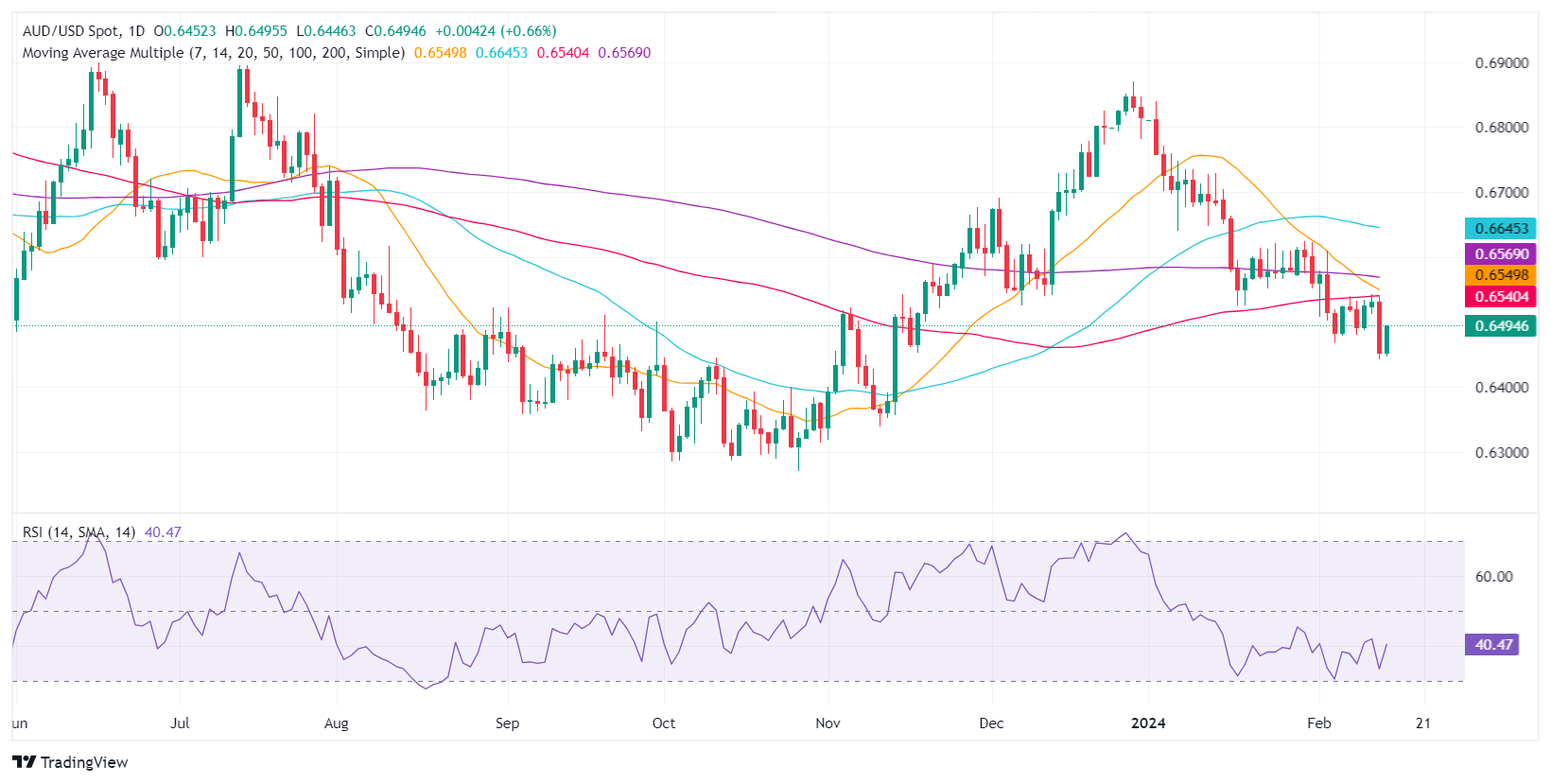
-
14.02.2024 15:35AUD/USD: Bearish forecast profile going forward – Danske Bank
The Australian Dollar (AUD) has been among the weakest performing G10 currencies in early 2024. Economists at Danske Bank analyze Aussie’s outlook.
RBA maintained its monetary policy unchanged in February
The Reserve Bank of Australia (RBA) maintained its monetary policy unchanged in February. While inflation slowed down more than expected in Q4, RBA’s communication remained hawkish due to still tight labour markets and elevated domestic price pressures in the services sector. Market prices in the first rate cut only by Aug/Sep, but we see risks tilted towards an earlier start to the cutting cycle.
The latest move lower in the cross has been well aligned with our expectations, and we maintain a bearish forecast profile also going forward. Solid macro-outlook in the US, relative central bank pricing and sluggish growth in the key Australian export market China all weigh on AUD/USD going forward.
Forecast: 0.6500 (1M), 0.6400 (3M), 0.6300 (6M), 0.6200 (12M)
-
14.02.2024 14:06AUD/USD approaches 0.6500 despite US Dollar remains broadly upbeat
- AUD/USD advances toward 0.6500 as the RBA remains open for further policy tightening.
- Investors see the Fed reducing interest rates in June.
- Market participants await fresh guidance from the Australian Employment and the US Retail Sales data.
The AUD/USD pair marches toward the psychological resistance of 0.6500 even though the broader outlook for the US Dollar is bullish. The Aussie asset is up more than 0.4% in Wednesday’s early New York session as Reserve Bank of Australia (RBA) Governor Michele Bullock cautioned that the central bank remains receptive to further rate hikes.
While discussing the timing of rate cuts, RBA Bullock stated that the central bank might consider initiating rate cuts even before inflation decelerates to 2.5%.
Going forward, the Australian Dollar will be guided by the Employment data for January, which will be published on Thursday. According to the expectations, 30K workers were recruited against 65.1K lay-offs in December. The Unemployment Rate is seen rising to 4% from 3.9%. An upbeat Employment data would allow RBA policymakers to hold the Official Cast Rate (OCR) at 4.35% for longer.
Meanwhile, the US Dollar Index (DXY) is struck near a three-month high of 105.00. The USD Index is expected to witness more upside as stubborn United States inflation data has shifted expectations for rate cuts by the Federal Reserve (Fed) to the June monetary policy meeting. The Fed is expected to keep interest rates unchanged in the range of 5.25-5.50% until it gets evidence that inflation will comfortably return to the 2% target.
For further guidance, market participants will focus on the monthly US Retail Sales data for January, which will be published on Thursday. Retail Sales are forecasted to have contracted by 0.1% after expanding by 0.6% in December.
© 2000-2024. All rights reserved.
This site is managed by Teletrade D.J. LLC 2351 LLC 2022 (Euro House, Richmond Hill Road, Kingstown, VC0100, St. Vincent and the Grenadines).
The information on this website is for informational purposes only and does not constitute any investment advice.
The company does not serve or provide services to customers who are residents of the US, Canada, Iran, The Democratic People's Republic of Korea, Yemen and FATF blacklisted countries.
Making transactions on financial markets with marginal financial instruments opens up wide possibilities and allows investors who are willing to take risks to earn high profits, carrying a potentially high risk of losses at the same time. Therefore you should responsibly approach the issue of choosing the appropriate investment strategy, taking the available resources into account, before starting trading.
Use of the information: full or partial use of materials from this website must always be referenced to TeleTrade as the source of information. Use of the materials on the Internet must be accompanied by a hyperlink to teletrade.org. Automatic import of materials and information from this website is prohibited.
Please contact our PR department if you have any questions or need assistance at pr@teletrade.global.















